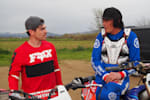Mountain
bike races are like adventure school camps for adults. And similar courtesies
apply
If you are
a newbie, there are some unwritten rules best adhered to
These simple
practises will make it nearly impossible for experienced riders to know you
haven’t done this before
Mountain
biking is expensive and immersive. South Africa has an embarrassment of races
and they provide both an opportunity for urban escapism and networking
prospects.
Here’s our guide how to play it cool at a local mountain bike race.

Stage race rule 1: Be courteous
Navigating downhill singletrack is what defines mountain biking and for some, it’s a lot more challenging to ride than others.
If you are a brilliant singletrack descender, a South African mass participation mountain bike race is perhaps not the best place to show off your skills.
Nervous descenders can quickly compound traffic down a trail and buzzing their rear wheel merely inflates the probability of an annoying, and avoidable, accident.
By the same accord, if you are an unconfident descender and happen upon the drop-in point of a long singletrack descent at the front of a group, the defining courtesy is to stop and ask if anyone behind would like to go ahead of you.

Stage race rule 2: Keep left. Pass right.
In South Africa we drive on the left, and pass on the right. Most mountain bikers also own and operate a car, so you have excuse for not understanding the principle.
In mountain biking, on open district roads and long jeep track climbs, the same principle applies. It’s deeply irritating for stronger climbers when they are trying to pass a slower group of riders idling up a gradient, and find people riding socially side-by-side, blocking the entire route.
On a climb, if you are going to ride side-by-side, always be aware of who is possibly gaining from behind and ensure you can quickly steer left and out of the way, without causing a collision.

Stage race rule 3: Don’t stop-and-drop your bike at the waterpoint
They call
them waterpoints, but mountain bikers also stop at them to energize at the
adjoining food tables. It can get crowded and chaotic, and as we all know – none
of use think properly when tired and hungry.
Keeping the
traffic flow ordered at these waterpoints, it’s crucial to not double-park your
bike. Never stop-and-drop your bike right next to the water containers or food
tables. It’s bad manners, your bike is in everyone else’s way and becomes a
possible injury risk as people scramble for energy drinks and jelly babies.
Always pedal just beyond the waterpoint and cache your bike off the riding route. It’s a few moments of effort but if everyone does this, the efficiency gain and frustration avoidance at water and food stops become a benefit for all.

Stage race rule 4: Party at a venue, not between the tents
For multiday races, there is always the social element after dinner.
Most race venues are skilfully configured in a camp where tented accommodation and socialising venues are separated. It’s because they don’t want you to have a social gathering with your mates, where other riders are trying to recover.
Tents are for sleeping and silence – which is why mobile phones are best left set to silent when the sun sets in any race village.
The chill zone is for recounting trail heroics and strategizing about the next day’s riding, whilst recovering on bean bags.
Stage race rule 5: Don’t drive over someone’s bike
It might
seem obvious, but when the race is done, and the victorious participants (or
tired survivors) are preparing to drive home, mistakes happen.
Bikes are haphazardly left strewn about between and behind vehicles in the race venue’s parking area, which is usually a field.
And when you are either tired or euphoric, it’s easy to be inattentive and accidentally reverse over someone else’s bike – which is guaranteed to ruin it and suspend any opportunity of possible friendship.




